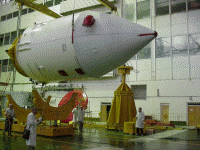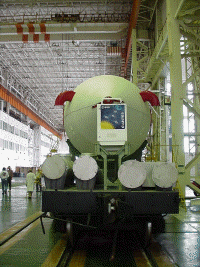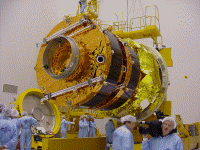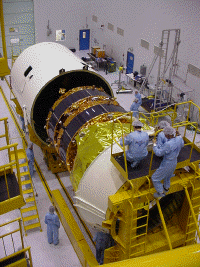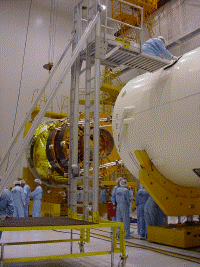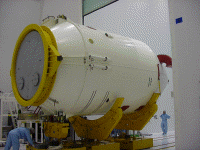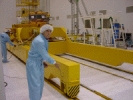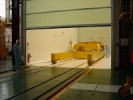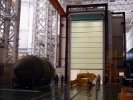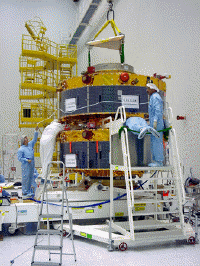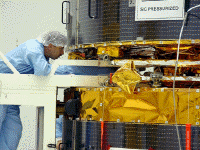23 June - 6 July 2000
6 July 2000
Following a successful Flight Readiness Review (FFR) on 23 June, all proceeded with the launch preparations for the first pair of Cluster spacecraft. During the reporting period, the FM 6 and FM 7 spacecraft were stacked together and mated with the ACU adapter. The stack was then transferred to the Upper Composite Integration Facility clean room, where it was mated with the Fregat stage, followed by the fairing encapsulation.6 July
Standby of the upper composite in MIK 40. Normal "baby-sitting" activities are performed (e.g. air conditioning and purging).
5 July
Arrival of the train in MIK 40 at 06:00. All nominal.
3 - 4 July
The upper composite was transferred from the Upper Composite Integration Facility (UCIF) to a train platform, for later transportation to the "MIK 40" facility for integration onto the Soyuz rocket.
|
Above: Upper composite is hoisted up Right: The upper composite installed on the train platform |
Departure took place at 21:30 with an estimated time of arrival twelve hours later. To avoid shocks and too much fatigue on the structure during transport, the speed of the train was reduced to less than 10 km h-1.
Meanwhile, activities on F8/F5 either go on (spacecraft mass property analysis/report) or are resumed (Propulsion Ground Support Equipment (GSE) cleaning and packing / Battery set up and conditioning).
2 July
Today the upper composite was tilted into the horizontal position and encapsulated into the fairing. This is a very delicate operation and alignment of both the fairing and the composite is the key for a successful operation (expected margins of error were about 4 cm!). Despite that, this operation was performed, once all alignment connections/verifications were made, in about 15 minutes. Fairing installation (left to right, top to bottom):
The upper composite integration is now completed.
1 July
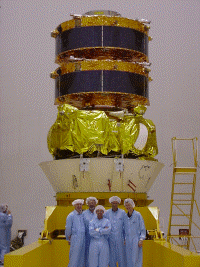 |
After some limited functional and pyro tests, all red tag items were removed (with the exception of pyro lines!)
Preparation of the upper composite, tilting it from a vertical to a horizontal position.
1 July was the last opportunity to see the spacecraft in vertical configuration!
Left: Stack mated with Fregat upper stage, after red tag removal
30 June
Mechanical mating of the Cluster II stack (F6/F7/Adapter) to the FREGAT upper stage. This was followed by the completion of all electrical connections of the "upper composite" (F6/F7/Adaptor/Fregat upper stage).
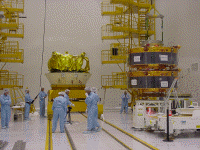 |
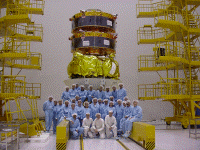 |
27 June
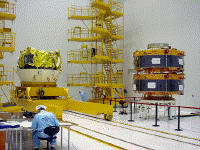 |
The Fregat stage is now inside the UCIF clean room, expecting the next major operation - the mating of the FM 6-FM 7 Cluster II stack - which is due to take place by the end of this week. In the meantime, some minor mechanical and thermal work is performed: installation of thermal blankets; verification and cleaning of the interface for Cluster etc.
26 June
The Fregat stage has arrived inside the Upper Composite Integration Facility (UCIF) clean room. First, its support adapter was rolled out of the clean room via the air lock, then the Fregat stage inside a container was moved inside building 112 on a special wagon. The Fregat container was then hoisted down onto the floor. The container was opened and the Fregat stage transferred and installed on its support adapter. Afterwards, the Fregat stage was rolled inside the air lock of the UCIF clean room, where it was thoroughly cleaned before being moved inside the clean room itself. For that operation, the entire area was evacuated to prevent the various teams from accessing the clean rooms.
Despite the fact that the clean rooms were inaccessible, the FM 6-FM 7 stack had previously been connected via its umbilical, so both spacecraft could be successfully switched on to perform an complete AFT (Abbreviated Functional Test). This AFT test consists in checking the status of the spacecraft by performing short essential tests for the sub-systems and the experiments.
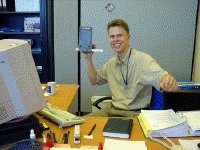 |
|
Markus Ranne |
The leg between Moscow and Baikonur is not a commercial line and the flights are organised by the RKA, the Russian Space Agency. There is normally one flight per week on a Tuesday. In this holiday period, almost all planes are fully booked. Therefore, alternative solutions have to be looked at - finding seats on a Russian military flight or booking a charter flight, possibly in combination with other organisations (e.g. ILS; Energia). This time, the exercise has been exhausting as none of the possible solutions materialised, despite a lot of phone calls, promises etc. - hence the nervousness of Markus!
The spacecraft filling team has started to pack its equipment inside the 20 feet transport container after the successful filling of the 4 satellites last week.
25 June (Sunday)
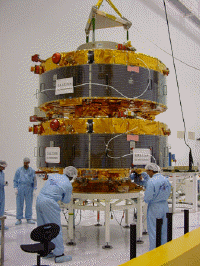 |
Today, the FM 6-FM 7 stack was mated on top of the ACU (Adaptateur Charge Utile) adapter, which is our mechanical and electrical interface to the launcher. Again, this activity was conducted with great caution, as more than 1500 kg of propellant were up in the air!
First, the stack of the two spacecraft was placed onto the adapter, then the clamp band was installed, positioned and tensioned. Afterwards, the umbilical and pyro connectors were installed, connected and verified. The installation of the connectors was also a delicate task needing some adjustment and patience: these connectors are retractable and need to be plugged-in and unplugged very smoothly.
24 June
For the people who persisted in waking up for a second consecutive day at 4 in the morning, their efforts were rewarded with a beautiful Proton launch at 6:34 (local time). The flight was the first of four scheduled in the coming four weeks, culminating with the launch of Zvezda in mid-July. The launched satellite is a Russian telecommunication spacecraft called Express 3A, built by NPO with an Alcatel payload. The 3-stage Proton vehicle took about 6.5 hours to deliver the satellite to the planned geosynchronous transfer orbit before the spacecraft boosted itself into its final geostationary orbit. The flight took off just after sunrise over the Kazakh steppe, which was really a very nice visual surprise.
 |
After the rush of the 2 days before, the site and the hotel look empty. The departure of the journalist and FRR group was not without its problems, as one of the two buses carrying the 70 people to the Baikonur airport (for their trip back to Europe via Moscow) had its rear axle broken. All the passengers had to pack themselves and their luggage in a single bus and continue their remaining trip to the airport (about 30 km) in the intense heat. That was not the best start for them for their return journey...
The end of the story of the bus is bad: it was repaired during the day and continued its journey back to the city for about five kilometres. Then it stopped again, this time with an engine problem. The next day, it was still in the middle of the road with its engine compartment completely open and the rear wheels dismounted...
A major event for FM 6 and FM 7. Since this afternoon, the twin spacecraft have been stacked together inside the Upper Composite Integration Facility (UCIF) clean room, and they will now remain together until they are placed into orbit. The operation was as follows:
- Installation of hoisting device on top of FM 7
- hoisting of FM 7 above FM 6
- lowering of FM 7 on top of FM 6
- installation of clamp band
- positioning, centring and tensioning of the clamp band.
The impressive operation took about 4 hours and was carried out with great care, especially during the dynamic phase. The tensioning of the clamp band was not easy as the workers had to operate on a specially made platform between the two spacecraft, which were less than 40 cm apart.
See pictures in chronological order (left-right, top-bottom):
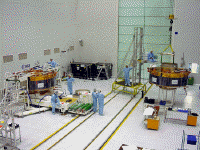
|
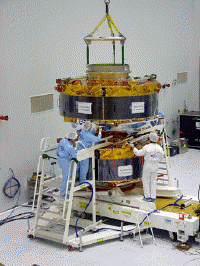
|
|
Stacking of FM 7 on top of FM 6 | |
23 June
The FFR (Flight Readiness Review) has taken place successfully here in Baikonur. After hearing several presentations on the status of the mission (spacecraft; ground segment; data science centre; Soyuz launcher and Fregat stage), the Board has authorised the Project to continue with the launch preparation activities. The meeting was held in a very good spirit and in a warm atmosphere... not least because of the outside temperature (39 °C)! Some of the participants at the day-long meeting were quite tired, not only because of the jet lag and the climatic conditions, but because some of them awoke very early to attend the Proton launch (4:00 local time) which was finally aborted later that day.
Validation of the links are still going on at the launch pad, but the communications with the people on top of the launch tower, where there is no phone, are not easy by VHF. Therefore, to communicate with the top of the launch tower from the bunker or the catacombs, one had to rediscover the old techniques of communication by signs (semaphore): arms up OK; arms down not OK; arms waving once, telecommand is sent; twice, telemetry is received, etc. At a time of global communication with internet, old communication means are still used in some areas of the world even for what is supposed to be high tech hardware!

